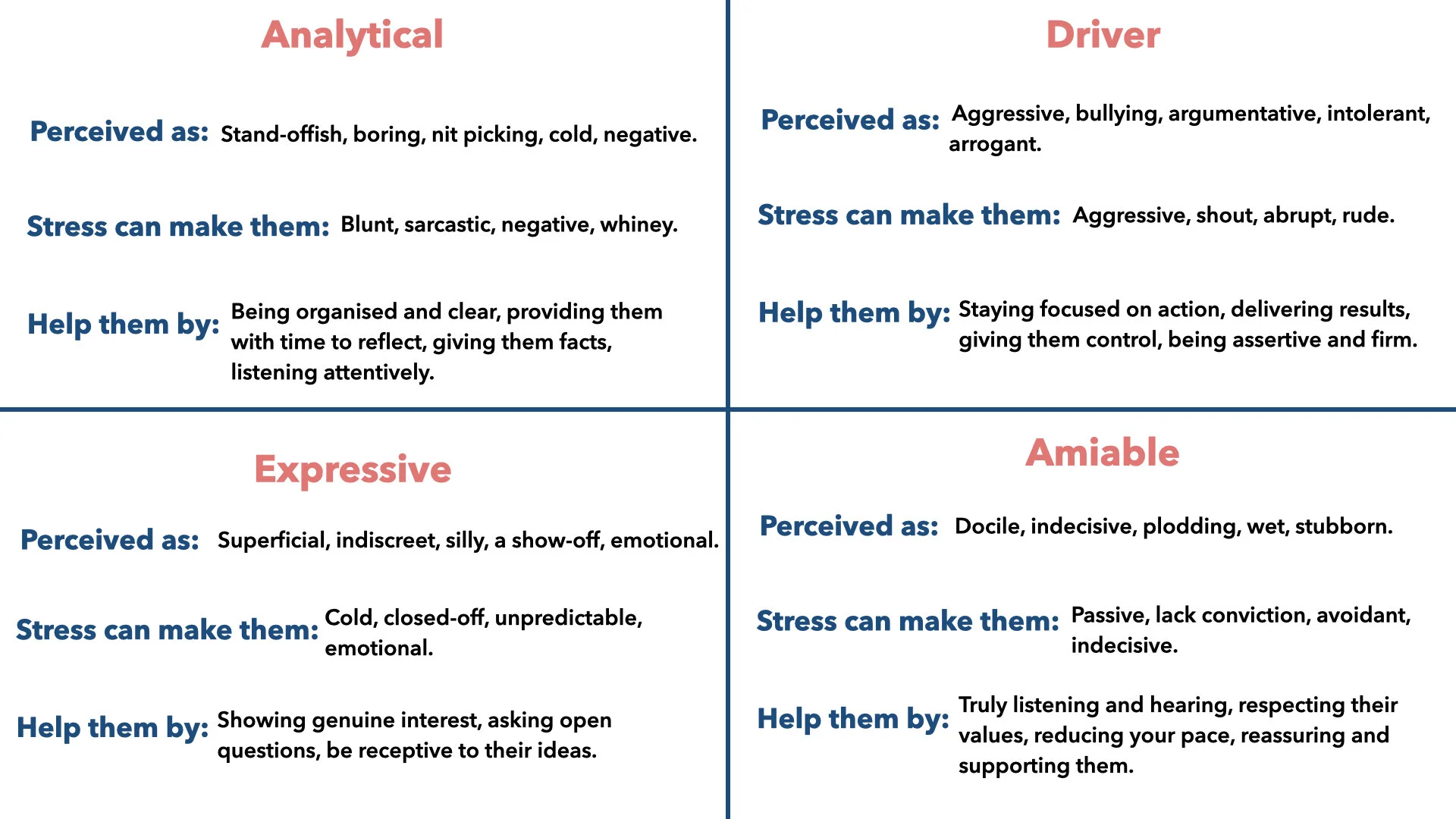How Different Personalities Respond to Stress
How Different Personalities Respond to Stress
We all respond to stress in different ways. How well we cope when things are on top of us depends on a number of factors, however, the thing that underpins how we cope with and display signs of stress is our personality.
There are many psychometric tools out there that can be used to measure personality. The likes of Insights, Myers-Briggs Type Indicator and The Big 5 Personality Traits are probably amongst the most popular tests. Here at T2, we use Social Styles, which establishes how we interact with others, and PRINT®, a psychometric tool that uncovers a person’s unconscious motivators which drive our external behaviours. For the purpose of this pathway, we’re going to focus on the impact stress has on the different social styles.
From a physiological point of view, when we’re stressed, we all suffer from the same symptoms. An increase in the brain chemical cortisol leads to an increase in blood pressure and heart rate, we feel fatigued, run down, and our immune system suffers. However, depending on our personality, we can all react to stress in different ways. Some of us may become withdrawn, others appear irritable, some people may become emotional. Stress presents itself in different ways and being able to identify when someone is suffering from stress is a great skill to have, particularly in the workplace.
To see how personality and stress interlink, let’s look at the descriptions of the 4 different social styles.
Analytical
Not known as an assertive social style, the analytical is very much as it suggests. The analytical tends to be process driven, with an attention to detail, facts and figures. The analytical stays clear of ambiguity and a lack of clarity, so when meeting with an analytical, be prepared with the relevant information and details of your suggestions and proposals. Analyticals use evidence and data to make sense of situations and decisions, therefore, rushing an analytical or asking them to make a quick decisions will only lead to resistance, push-back and at times, disengagement.
Driver
This is the most assertive of the 4 styles. The driver will often come across as being very direct and sometimes a little abrupt. In truth, the driver is very efficient, has little need for emotional investment and is very goal oriented; this is why they can appear to be short and abrupt. To communicate with the driver successfully, you need to adopt the traits that they appreciate, for example, efficient, short and concise emails and phone calls. Skip the detail, be specific on the outcome you require, and - above all else - move out of their way and allow them to be in control.
Expressive
This is less assertive than the driver, but is still an assertive social style. The difference is that the expressive is much more invested in other people than the driver. The old expression “people buy from people” is very effective when dealing with the expressive. Creativity and people are at the very centre of the expressive's world, so when dealing with this style, be sociable, friendly and emotionally invested in order to collaborate with them and gain buy-in.
Amiable
The amiable is known to be a balanced and approachable social style. The amiable is a very harmonious person who has core values around people working collectively and collaboratively, bringing great balance when dealing with more assertive styles. Don’t push the amiable for instant decisions or immediate output, or you’ll soon distance them. Conflict is also something that the amiable will avoid at all costs. Don't come on like a gangbuster or be aggressive and confrontational or they’ll simply withdraw.
Now let’s see how each style reacts under stress, how others may perceive them and how best to help them.
Even if you haven’t taken the social style test, from the above, you may be able to recognise which social style you are, as well as recognise the social style of those around us. Knowing how certain personality styles behave when stressed, and more importantly, the best ways to help them, is valuable knowledge to hold, particularly if you are in a leadership position.
As most of us will have taken some sort of personality test at some point, we thought we would create a chart that shows how each personality test can interlink into each other. It’s not an exact science, however, will mean that more people can relate to the above and help recognise when they or someone else is suffering from stress and how to overcome it.
In Summary: stress is something that we will all experience at some point in our lives, however, depending on our personality, can present itself in very different ways. Being able to recognise when we or someone we know is suffering stress and know how to help ourselves and others is a great skill to have and as a result, can prevent stress from developing from an acute problem, to a chronic one.


